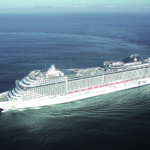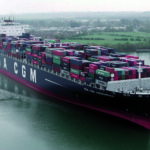International classification society Bureau Veritas has introduced a Green Rating Composite Index which will provide charterers and regulators with a[ds_preview] tool to compare the environmental performance of ships and will give owners a tool against which to assess environmental investment in the vessel.
The Green Rating Composite Index builds on BV’s international experience with rating the environmental performance of buildings and its research into new technologies to make ships more fuel efficient. »To encourage the market to use the most environmentally-friendly ships, and to encourage owners and yards to invest in greener technology, we must have a clear standard to compare the environmental performance of ships«, explains Didier Chaléat, Senior Vice-President, Bureau Veritas.
»We have started two years ago with our Golden Pearls labels to allow cruise companies to show to the public the specific attention paid to environmental matters related to air, water and waste emissions. But that is not enough for general shipping. There are moves to develop schemes in shipping but the lead has come from other industries where such indices already exist. So we have used BV’s experience in other fields to benefit shipping by developing this new Green Rating scheme which can apply to great variety of ships. It will be a powerful tool for creating meaningful green comparison in the market place and for helping owners differentiate investment efficiently.«
The Bureau Veritas Green Rating Composite Index is built on two indexes which bring together a set of measurable variables in two ways. The indexes measure five variables:
1. Energy performance(in kJ / tonne / mile or kJ / passenger / cruise day)
2. Greenhouse gas emissions (in kg / tonne / mile or kg / passenger / cruise day)
3. SOX emissions (in kg / tonne / mile or kg/passenger / cruise day)
4. NOX emissions (in kg / tonne / mile or kg / passenger / cruise day)
5. The period the vessel can operate without discharge of fluids such as black water or grey water.
These variables are first calculated using the ship’s design performance criteria for a set of recognised standard operating conditions and combined to produce an Intrinsic Index. This Intrinsic Index figure can then be used to compare all vessels on a like for like basis, as the calculations always refer to the same standard operating conditions.
Separately all the variables are also measured in service for the actual trade routes or real operational profile of the vessel. The measured values are combined to produce an Actual Index. This can be compared with the more theoretical standard situation of the Intrinsic Index.
Both Indexes can be used to calculate the effects and benefits of different potential investments in green technology, such as scrubbing, new waste handling plant or fuel consumption reducing measures. That provides a better estimate of the relevant investment payback for any potential green investment.
Says Chaléat, »We have seen these indexes work in other industries, now it is time for shipping to take this up. We can help ship users compare ships, help owners who have invested in green technology to prosper in the market place and help owners who wish to invest and upgrade their vessels or change operational practices to target their investments where they will do most good. And also help of them to quantify, accelerate and publicise the results of their efforts to be more environmental friendly and energy efficient.«
MSC Cruises sets new standards for cruise vessel QHSE
With the entry into service of the 3950-passenger »MSC Fantasia«, MSC Cruises has raised the Quality, Health, Safety and Environment (QHSE) bar for all cruise operators. MSC has entrusted Bureau Veritas with the auditing of six of the highest possible QHSE standards for the design of the new ship and also its operation in service, granting the »6 Golden Pearls« designation for best new building ship for environmental care!
Senior Vice-President Didier Chaléat says, »MSC really cares for its passengers, its crew, the ports visited, the sea and the environment. By working with the classification society during the design and build of this cutting edge vessel, they have ensured that it was built and equipped to exceed all current environmental standards. But they have gone further, and have set up company-wide schemes to ensure that there is a constant environmental performance improvement, that safety is constantly improved, and that the food management chain is covered by a food safety management system audited to the very highest standards. MSC is going really far in protecting the environment, the passengers and its crew!«
»MSC Fantasia« has been designed and built so that it could be awarded Bureau Veritas’ highest voluntary notation for environmental protection, Cleanship-AWT. Key benefits provided include for water quality a top of the art advanced waste water treatment and the capability to retain all grey and black water for two days full operation. Additional bilge water capacity is also built in to provide full two day retention for treated bilge water, over and above the latest Oily Water Separators. Hull antifouling conforms to the IAFS Convention on the control of harmful anti-fouling systems and ballast water management complies with the new International Convention and Management of ship’s Ballast Water and Sediments.
Air quality is protected by ensuring that low sulphur fuel is used worldwide, and the main and auxiliary engines have been certified for NOx emission in accordance with latest IMO-MARPOL Annex VI requirements. Flue gas from shipboard incinerators is controlled and ozone depleting substances prohibited.
Solid wastes do not need to be discharged at sea due to the high incineration capacity, and additional storage facilities for more than two days full operation for the remaining ashes, glass, tins, cold and wet garbage are built in.
While many of these design features break new ground, what makes »MSC Fantasia« unique is the systematic control of QHSE issues in service. In order to maintain the notation Cleanship-AWT specific and regular duties must be carried out by the crew and management during operation of the vessel, re-enforced by onboard surveys, with periodical tests, measurements and reporting, controlled by MSC’s operation and technical management and audited by BV’s experts.
MSC is implementing an Environmental Management System under ISO 14001. It requires a complete management system for the environmental impacts from the company’s operations, and continuous improvements. The classification society has already carried out certification audits on the head office of MSC CTD in Piano di Sorrento and on a large part of MSC Cruises’ existing fleet. The system was extended to cover »MSC Fantasia« as soon as she entered service, and all newbuildings for MSC will also enter the system.
In addition MSC has put in place OHSAS 18001, the highest standard for certification of a company’s safety management system. It requires a complete management system of safety and security of workers both on board and at the head office. Four vessels have been audited on board during the certification audit, three more will be audited under the annual surveillance audit and three more in the second annual surveillance audit. »MSC Fantasia« has entered the system from day one.
Food safety cannot have too high a priority for cruise ship passengers, so MSC has opted for ISO 22000, the highest standard for certification of a company’s food safety management system. The project was developed especially for onboard food preparation and the supply chain. Audits were carried out on board the entire cruise fleet and certification was granted in June 2008. As newbuildings were delivered ISO 22000 was implemented on board.
»With ›MSC Fantasia‹ MSC Cruises has obtained the »six best QHSE standards«, for the special attention paid during design and building to air, water and waste domains, and during operation, to environmental, safety and food care,« says Didier Chaléat. »This is presently the highest standard set for cruise vessel newbuilding with BV class.«
The classification society currently classes 459 passenger ships and ferries worldwide. Its newbuilding order book includes nine cruise ships and thirteen other large passenger vessels, building for twelve owners in seven different countries. As the world leader in QHSE across all industries, Bureau Veritas is uniquely placed to set and maintain the highest standards of safety and environmental management for the leisure industry.
Philippe Boisson




















